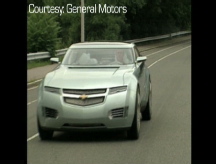Chevy Volt is no "electric Camaro"
For efficiency's sake GM's electric car will look a little tamer than the concept car, but still no Prius.
 |
| The production version of the Volt have a softer look than the 2007 concept car, shown here. |
| 36 month new | 5.91% |
| 48 month new | 5.98% |
| 60 month new | 6.03% |
| 72 month new | 3.78% |
| 36 month used | 6.31% |
WARREN, Mich. (CNNMoney.com) -- General Motors is on track to begin production of the Chevrolet Volt in 2010, according to GM executives involved in the car's development. But consumers should ready themselves for something a little tamer-looking than the concept car GM revealed in January 2007.
A recent visit to GM's Design Center in Warren, Mich., provided a look at design sketches and life-size models of the interior and exterior of the production Chevrolet Volt. Parts of the models were kept covered, but large portions of the front and rear ends of the life-size models were revealed.
Designs are very nearly finalized, according to Bob Boniface, head of design for the Volt program, with only minor details needing to be worked out.
The Volt will run on electric power stored in large lithium ion batteries. Plugging the vehicle into a wall outlet overnight will provide enough to power to drive the four-door sedan about 40 miles, GM (GM, Fortune 500) says. Beyond that, a small gasoline engine will act as a generator to pump more electricity into the batteries.
The concept version unveiled at the 2007 Detroit Auto Show looked nothing like the high-tech, fuel efficient cars consumers were used to seeing. With its sharp angles, long hood, and wheels out at the corners of the body, the Volt concept looked like a futuristic performance car, not a high-efficiency people mover.
Inside GM, it was referred to as the "electric Camaro," said Boniface.
But there's a reason that fuel efficient cars don't look aggressive. A flat front end and sharp front corners are bad for air flow. The production car will have a rounded nose and tapered corners, while still retaining key styling elements of the concept car.
"We wanted to make sure the car had a good balance between aerodynamic performance and styling for the customer," said Bob Boniface, director of design for the Chevy Volt.
From the back, the production Volt will retain more of those sharp edges. In fact, the back of the car will have even sharper angles than the concept. In the rear, where air flows off and away, sharp corners actually help improve airflow and reduce efficiency-sapping drag..
For mechanical, as well as aerodynamic reasons, the front wheels also had to be moved further back in the body, giving the car a longer nose.
Inside, the Volt will look somewhat like a high-tech version of the successful Chevrolet Malibu sedan, borrowing the "twin-cockpit" design theme that is becoming a style signature for GM's Chevrolet brand.
Some potential buyers might be disappointed at the production Volt's tamer look, said Dr. Lyle Dennis, a New York-area neurologist who runs the Volt fan blog GM-Volt.com. Dennis has also seen GM's mock-ups.
Most buyers, though, will be interested in what the car can do, not how it looks, he said.
"I think people recognize it's the technology that it's really all about," he said.
Driving the Volt won't be any different from driving any other car, said GM's Boniface. It won't have a high-tech electronic shifter of the sort found in the Toyota Prius or a BMW luxury car. In those vehicles, a small switch is toggled up and down to select "Drive" or "Reverse," for instance.
The Volt, like most cars, will have a mechanical gear selector. You'll grab a big shifter between the seats and pull it back to select "Drive."
That might seem low-tech for such a high-tech car but, Boniface points out, those gear selectors use electricity. In a car with a promised 40-mile range on plug-in power alone, electricity is at a premium. So you can expect to see as little electricity-draining technology on the Volt as possible.
"We want it to be seen as something unique, but not something that people are going to have to re-learn how to use," said Boniface.
The Volt will be a four-seat sedan. Most sedans these days squeeze in at least nominal space for a fifth passenger but to do that while allowing room for a battery pack running along the center of the floor would have required more headroom. That would have meant raising the roof a little which would have hurt fuel economy.
Even while trying to maximize efficiency and range, designers were careful not to strip away too much of the Volt's personality, said Boniface. The car will look nothing like Toyota's (TM) egg-shaped Prius hybrid.
"From what I've seen, it's going to be really cool looking," agreed Dennis. ![]()


